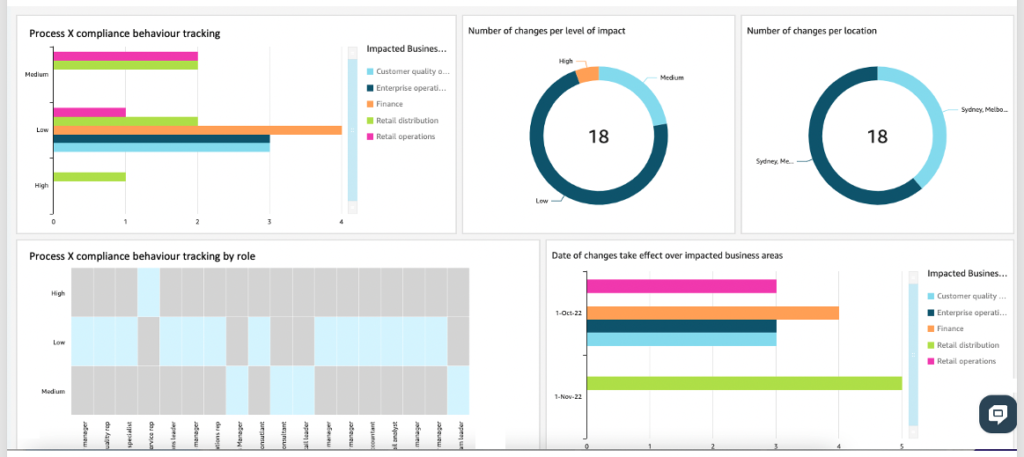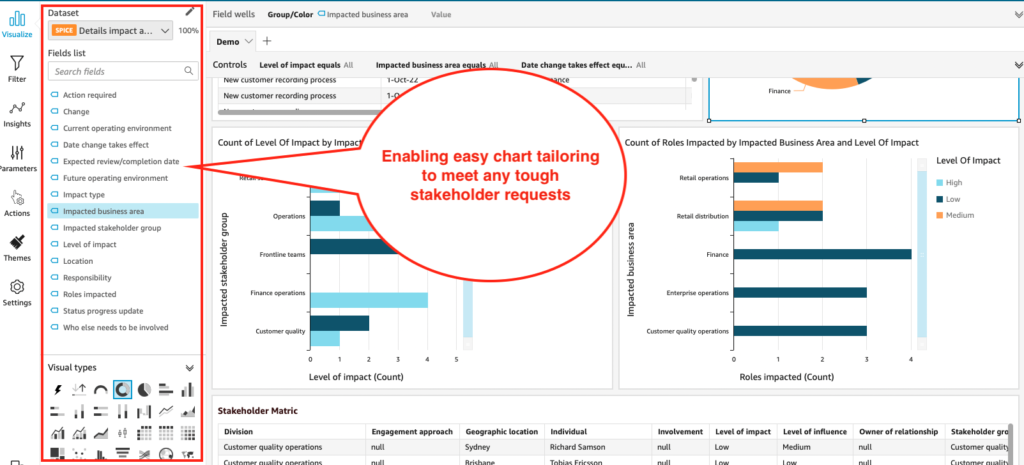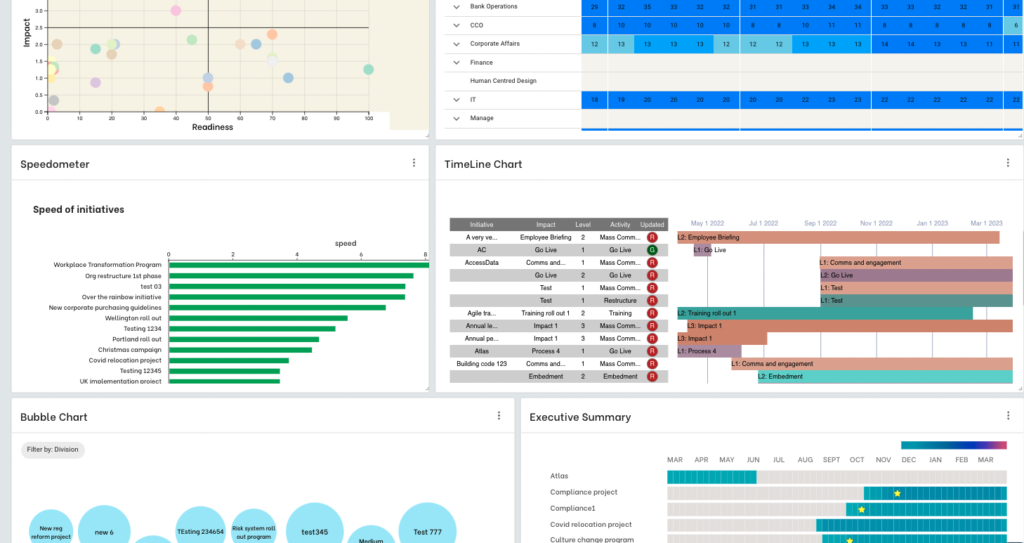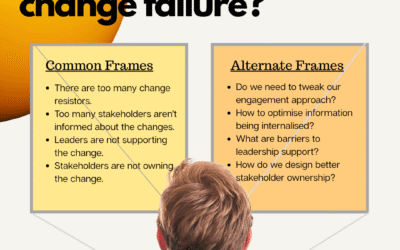It used to be that change management is the ‘poor’, neglected cousin of other disciplines in terms of access to functional software to assist in its performance. There is a wide range of software available for a range of project management disciplines such as, business analysis, testing, project management, portfolio management, etc. However, for change management the pickings have been almost non-existent 10 years ago.
Fast forward to 2022, there is now a handful of change management software in the market to assist with various work categories for the change manager. However, there is still ways to go in the understand of organisational change management in the marketplace. Compilations of change management software offering on the internet is usually a mixture of all types of software, many of which are not organisational change management in nature, and instead, technical change management (used by IT folks). For example https://orgmapper.com/change-management-tool/
How can change management software help the change practitioner?
Project change delivery
The vast majority of change management professionals in the industry are focused on delivering projects. It’s no wonder that most change management tools are focused to support project delivery as a result. What are some of the areas in which project change delivery work can be made easier by software?
1. Automating change management deliverable work
A significant part of the work of change management professionals is spent on preparing for and documenting change management deliverables. These include detailed impact assessment, learning plan, stakeholder matrix, etc. These deliverables are critical documents which are critical dependency for other project milestones. For example, stakeholder analysis and matrix is critical before broader stakeholder engagement can be made, since the analysis reveal who the stakeholders are and how they may be engaged throughout the change process.
One of the biggest pains faced by change management professionals is the amount of time required to manually create these deliverable documents. The work can be tedious, requiring weeks of manual work to complete. For example, the stakeholder matrix document can be a brain-numbing piece of activity, wading through a data dump of the organisational directory to determine every Tom, Dick and Harry which titles and names should be included in the stakeholder list for the project. Then, a lot of similar information then must be re-typed and entered into different versions in other change management deliverable documents such as detailed impact assessment or learning needs analysis.
Software can automate much of the manual work involved. For example, Change Automator allows the ability to link data already captured earlier on in the project, such as the stakeholder matrix, with other change management deliverables such as detailed impact assessment, to minimise manual re-work. Any data updated in one document, will therefore update content in other documents. This then saves on the tedious re-work required when data is updated or changes, which is pretty much a given throughout the project lifecycle. From a quality perspective, this also ensures any human-error is reduced in the data that should be synchronised across documents.
A common risk in change management delivery is that stakeholders may be left out inadvertently, or that a previously captured stakeholder in the stakeholder matrix is left out in the engagement process due to human-error. The impact of this type of error can be disastrous to the outcome of the project. Having cross-linked documents in one central place reduces the risk for this type of error.
2. Change management survey (readiness and adoption)
A key part of change management success is through careful monitoring of stakeholders throughout the change process. In the earlier part of the project, this involves understanding to what extent stakeholders may be clear of the objectives of the project, their roles in it, and general awareness. Later on in the project, it could be more on understanding their engagement level which can be a predictor of ultimate adoption and overall support for the change. This overall change readiness level should be monitored across the project through surveys or interviews.
Surveys are inherently time consuming to design, administer and report manually. Significant time can be taken throughout each phase of the survey process. This is a no-brainer in terms of using a software tool. Most projects use Microsoft Forms or SurveyMonkey to do the job. However, you may want more robust features such as conditional question design, for example, if a respondent answers ‘yes’ for not supporting the change, then an additional question pops up to ask why.
Surveys can include sentiment analysis where the focus of the survey is on any shifts in stakeholder feelings and attitudes toward the project. In this case, it is critical to define in detail the characters of each stakeholder group in concern. These would then determine respondent characteristics to measure in the survey design.
There are also tools that measure employee sentiments through corporate social media channels such as Yammer and Teams. For example, Swoop Analytics can help to measure collaboration styles and other behavioural insights about how employees interact with each other on those channels. The data map can reveal key influencers and core influential network connectors.
The biggest value of change surveys lies in the reporting. Most survey tools offer fairly simple reporting using bar charts or pie charts. For short, simple surveys these may suffice. However, if you are working on a fairly detailed change adoption tracking survey, more advanced reporting features may be required. You may want to easily change the colour scheme of the chart, change different chart types, identify anomalies and trends, or highlight certain parts of the data to make it easier for your audience.

3. Project change reporting
Having the ease and flexibility of experimenting with different chart designs is critical for stakeholder impact. If you need hours of work to come up with a few charts the likelihood is that you will not bother. Some stakeholders may also have various personal preferences which can easily take significant time to modify. This is especially when you need the time to focus on engaging with your stakeholders, rather than tweaking excel spreadsheets.
Creating the right dashboard can create significant impact on stakeholders and help achieve your change objectives. Data speaks for itself and the right data visualisation can create memorable impact more than words alone. If you are driving toward change adoption, then having a dashboard of core behaviour changes and tracked capability shifts can act as a core part of change governance conversations. With a monthly cadence of reviewing these core data points, stakeholders can hold each other accountable to understand remaining work involved and zoom in on how to drive full change adoption.
Change reporting may not be limited to just survey results. Even seemingly ‘boring’ spreadsheet data such as detailed impact assessment may be easily turned into highly visual and interesting reports to help stakeholders understand what the changes mean and how different groups are impacted by the change.

For more tips on designing the right data visualisations check out our infographic Making Impact with Change Charts.
4. Learning
One of the more popular ways in which change delivery has adopted software is in leveraging digital tools that provide functions to onboard or train users of new or changed systems. There are numerous providers in this area. These include WalkMe, UserGuiding, and Userlane.
Most of the tools provide similar functions to help walk users through interfaces of the system and even allow interactive experience where users can be tested in clicking on the right part of the system as a part of the training or onboarding process. The application is always for system interfaces since the tool only supports web-based systems.
Change capability
Another way in which change management software may assist change practitioners is in change capability. There are various tools that help to measure, track and report on change capability. It could be that you would like to measure the change leadership skills of leaders, change agility of stakeholder groups, or test employees as a part of skills assessment to ensure they have the right skills for the new system or process.
Using change management software, you can easily pre-program test items and answers to make it easy for yourself to score and tabulate test results without any manual work. You can also assign weightings to different questions to evaluate the capability of the respondent as a part of an assessment. You can even configure the assessment to provide results to the respondent at the end of the assessment. Generally, these features are only offered as a part of a learning management system where significant time and effort is required to prepare the system for the assessment. Now, digital tools offer easy point-and-click features, with pre-configured templates saving you significant time and cost.
Change portfolio management
Managing a portfolio of initiatives used to be an approach only adopted by more mature organisations. However, with the rapid pace and intensity of changes, more and more organisations are adopting this approach to manage multiple initiatives.
Managing a portfolio of initiatives can only be done via data. There is already a myriad of project portfolio management systems in the market to help PMOs and project portfolio managers manage a slew of initiatives. The focus of project portfolio management systems is on project timelines, cost, resourcing, etc.
Change portfolio management focuses on the impact of changes and how they may impact the organisation across initiatives. There is also focus on change delivery resourcing and change capability development. One of the most critical pain points faced by organisations is change saturation and change fatigue. To better manage a portfolio of initiatives from a change perspective and manage potential change saturation, data is required.
Effective change portfolio management tools can help you:
- Identify and plot change saturation points for different parts of the organisation
- Identify risk levels of potential change saturation across roles, locations, layers of the organisations, etc.
- Assess to what extent changes may be better delivered as an integrated package to one part of the organisation, or broken down to smaller, more digestable chunks
- Assess to what extent changes may be better aligned and delivered through integrated messaging from an impacted stakeholder perspective (vs. from project perspective)
- Plan for change management delivery resourcing

To read more about managing a change portfolio visit 7 change portfolio management best practices.
In summary, there are many strong reasons why change management professionals should adopt digital change management solutions to achieve greater change outcomes as well as to automate the tedious parts of the work to gain time to spend with stakeholders. With the ever increasing pace of digitisation in organisations, change management must also follow suit in digitising itself. Just as we could use modern fabrication techniques to build skyscrapers that are stronger and more resilient vs using traditional brick and mortar, so should change managers in leveraging digital tools to support digital transformations.






